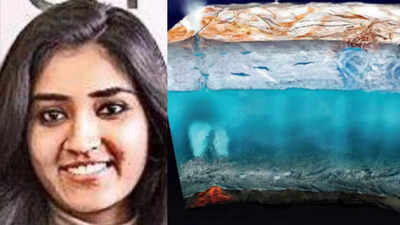- News
- City News
- ahmedabad News
- Ahmedabad scientist reaches for Jupiter’s moon to study its surface features
Trending
Ahmedabad scientist reaches for Jupiter’s moon to study its surface features
Nasa's Europa Clipper Mission, set to explore Jupiter’s moon Europa, includes Ahmedabad native Rutu Parekh, a post-doctoral fellow at the Jet Propulsion Laboratory. Her research focuses on Europa's surface and subsurface features, aiding the mission's goal to uncover potential life-supporting environments. Scheduled for a 2030 arrival, it aims to delve into Europa's habitability.

Rutu Parekh (left); Artist’s impressions of ocean beneath its icy surface (right)
On the Europa Clipper Mission’s science team at the Jet Propulsion Laboratory (JPL) that manages missions for Nasa is Rutu Parekh, a post-doctoral fellow, who calls Ahmedabad her home.

Parekh is an alumna of St Xavier’s College and Cept University in the city for BSc and MSc courses whose journey into planetary science began with an internship at the Physical Research Laboratory (PRL).

In an email interview with TOI, Parekh, a post-doctoral fellow working on the mission to find ‘ingredients of life’ on the moon, spoke about her contribution and why the interplanetary mission is an important one for mankind.
“For the past two years, I have closely collaborated with the project science team. My research focuses on studying the small-scale surface features of Europa and other icy worlds in our solar system and beyond, with the aim of understanding the surface and near-surface conditions on Europa,” she said.
‘Mission will deliver insights into Europa’s habitability’
Rutu Parekh, who earned her doctoral degree in planetary science from the Freie University of Berlin and German Aerospace Center (DLR), Germany, said that Europa is thought to conceal a vast subsurface ocean beneath its icy crust, potentially providing a stable environment for life.
And Europa Clipper, Nasa’s largest spacecraft, is expected to reach its destination by 2030 and perform a series of fly-bys to understand the composition of the icy moon, which is slightly smaller than Earth’s moon, to unravel its mysteries. “The Europa Clipper mission is poised to deliver crucial insights into the moon’s composition, geology and habitability, offering invaluable clues about the existence of habitable zones beyond Earth. This mission will not only deepen our understanding of Europa but will also shed light on the broader dynamics of icy moons, with implications for other Jovian moons such as Ganymede and Callisto, as well as Saturn’s Enceladus,” said Parekh. The mission will pave the way for future explorations, including landers that can investigate the surface up close, she added.

She said that Europa Clipper is pushing the boundaries of our knowledge about planetary formation, evolution, and the potential for habitable regions elsewhere in the solar system.
A Chevening Scholar, Pa rekh was supported by the German Academic Exchange Service for her PhD. Some of her early associations include MASCOT (Mobile Asteroid Surface Scout) Lander for the Hayabusa2 mission, and the Dawn Mission to Vesta and Ceres in the a steroid belt, among others.
The mission’s official launch date of Oct 10 was postponed due to Hurricane Milton. Nasa’s website indicates that the launch is no earlier than 12:06 pm Eastern Daylight-Saving Time (EDT) on Monday, Oct 14.
End of Article
FOLLOW US ON SOCIAL MEDIA










